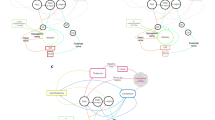Conclusions
-
1.
The microiontophoretic application of noradrenaline and the stimulation of the lateral hypothalamus identically influence the impulse activity of neurons in the reticular formation of fed, immobilized rabbits, increasing during combined action the number of cells with a distribution of intervals characteristic of feeding motivational excitation.
-
2.
The microiontophoretic delivery of acetylcholine to neurons of the orbital cortex under conditions of free behavior of rabbits stops the impulse activity of most of the cells in this structure, as is characteristic of feeding motivational excitation.
-
3.
Feeding motivational excitation, both natural and artificially induced, expands the polychemical properties of neurons in the reticular formation of rabbits by increasing the number of cells sensitive to two and more mediators and simultaneously reduces the number of monochemical nerve cells.
-
4.
Natural feeding motivational excitation increases the number of monochemical neurons in the orbital region of the cortex, correspondingly narrowing their polychemical properties.
Similar content being viewed by others
Literature cited
P. K. Anokhin, Biology and Neurophysiology of the Conditioned Reflex [in Russian], Meditsina, Moscow (1968).
P. K. Anokhin, “Systems analysis of integrative neuronal activity,” Usp. Fiziol. Nauk,5, No. 2, 5 (1974).
V. V. Andrianov, “Chemical sensitivity of cortical neurons in visual cortex to various stages of development of feeding behavior,” Zh. Vyssh. Nervn. Deyat.,30, No. 6, 1173 (1980).
V. I. Badikov, “Comparative characteristics of evoked cortical responses in the rabbit during stimulation of emotionally positive and negative zones of the hypothalamus,” in: Materials of the Symposium of the 24th All-Union Conference on Problems in Higher Nervous Activity [in Russian], Nauka, Moscow (1976), p. 44.
O. G. Baklavadzhan and V. S. Eganova, “Neuronal mechanisms of hypothalamo-reticular influence on cerebral cortical activity,” Usp. Fiziol. Nauk,13, No. 2, 3 (1982).
G. G. Gasanov, M. I. Zhadin, and Z. G. Mamedov, “Variations in the structure of background impulse activity of the cortical neurons under the influecne of noradrenaline,” Fisiol. Zh. SSSR,66, No. 10, 1446 (1980).
E. A. Gromova, “Reciprocal interrelationships of serotoninergic and noradrenergic cerebral systems,” in: Physiology and Biochemistry of Mediator Processes [in Russian], Nauka, Moscow (1976), p. 40.
B. V. Zhuravlev and N. N. Shamaev, “Analysis of impulse activity of neurons in orbital cortex of rabbits during feeding behavior,” Zh. Vyssh. Nervn. Deyat.,31, No. 5, 1010 (1981).
V. G. Zilov, “Integration of cortical-subcortical formations during development of various biological motivations,” in: Problems in Hypothalamic Physiology [in Russian], Vishcha Shkola, Kiev, No. 14, (1980), p. 13.
A. F. Kosenko and G. P. Gushchinets, “Involvement of adreno- and cholinoreceptors in mediating hypothalamic influence on gastric secretion,” Fiziol. Zh. SSSR,68, No. 4, 533 (1982).
A. F. Makarchenko, R. S. Zlatin, B. A. Roitrub, and R. R. Velikaya, Hypothalamo-Cortical Influences: Neurophysiological and Neurochemical Mechanisms [in Russian], Naukova Dumka, Kiev (1980).
D. V. Sukadov, ed., Systems Mechanisms of Motivation [in Russian], Meditsina, Moscow (1979).
K. V. Sudakov, Biological Motivations [in Russian], Meditsina, Moscow (1971).
S. N. Khayutin, “Characteristics of activity of single neurons in visual cortex under conditions of pronounced feeding motivation,” Zh. Vyssh. Nervn. Deyat.,22, No. 6, 1248 (1972).
S. P. Grossman, “Role of hypothalamus in the regulation of food and water intake,” Psychol. Rev.,82, No. 1, 202 (1975).
O. Kh. Koshtoyants, M. Yu. Markarova, and J. Yankel (Jankel), “Noradrenergic control of the sensitivity of brain neurons to acetylcholine: its role in conditioning,” in: Neurotransmitter Comparative Aspects, Akad. Kiado, Budapest (1980), p. 491.
S. F. Leibowitz, “Brain catecholamine projections: their function in control of spontaneous and drug-induced changes in feeding behavior, appetite, and body weight,” Phsychopharmacol. Bull.,17, No. 3, 59 (1981).
S. Miyahara and Y. Oomura, “Inhibitory effect of the ventral noradrenergic bundle on the lateral hypothalamic area in rat,” EEC Clin. Neurophysiol.,52, No. 3, 160 (1981).
J. Pankseep, P. Bishop, and J. Rossi, “Neurohumoral and endocrine control of feeding,” Psychoneuroendocrinology,4, No. 2, 89 (1979).
T. A. Reader, A. Ferron, L. Descarries, and H. H. Jasper, “Modulatory role for biogenic amines the cerebral cortex. Microiontophoretic studies,” Brain Res.,160, No. 2, 217 (179).
J. Rossi, A. J. Zolovick, R. F. Davies, and J. Pankseep, “The role of norepinephrine in feeding behavior,” Neurosci. Biobehav. Rev.,6, No. 2, 195 (1982).
M. Segal and F. E. Bloom, “The action of norepinephrine in the rat hippocampus. I. Iontophoretic studies,” Brain Res.,72, No. 1, 79 (1974).
P. Stark, J. A. Turk, and C. W. Totty, “Reciprocal control of hypothalamic elicited and satiety,” Am. Soc. Physiol.,220, No. 5, 1516 (1971).
W. Trojniar and D. Luszawska, “The effect of simultaneous intraventricular administration of noradrenaline and dopamine on lateral hypothalamic syndrome in rats,” Acta Neurobiol.,42, No. 2, 209 (1982).
B. D. Waterhouse and D. J. Woodward, “Interaction of norepinephrine with cerebrocortical activity evoked by stimulation of somatosensory efferent pathways in the rat,” Exp. Neurol.,67, No. 1, 11 (1980).
Author information
Authors and Affiliations
Additional information
Translated from Zhurnal Vysshei Nervnoi Deyatel'nosti imeni I. P. Pavlova, Vol. 35, No. 5, pp. 907–913, September–October, 1985.
Rights and permissions
About this article
Cite this article
Borisova, E.V. Neuromediator sensitivity of neurons of reticular formation and orbital cortex in fasted and fed rabbits. Neurosci Behav Physiol 16, 394–400 (1986). https://doi.org/10.1007/BF01185370
Received:
Issue Date:
DOI: https://doi.org/10.1007/BF01185370




